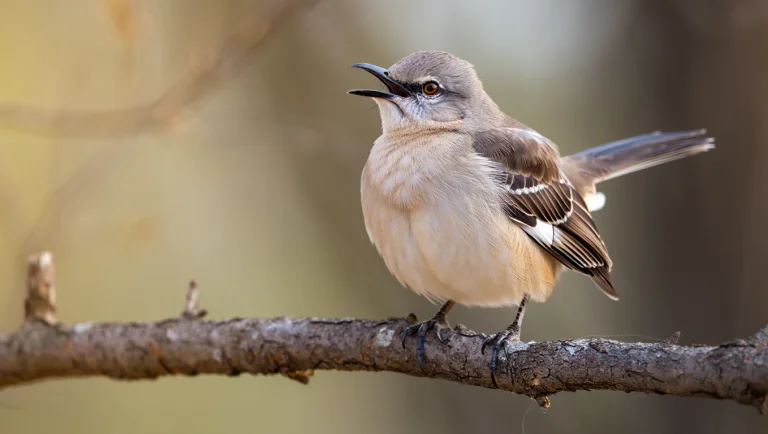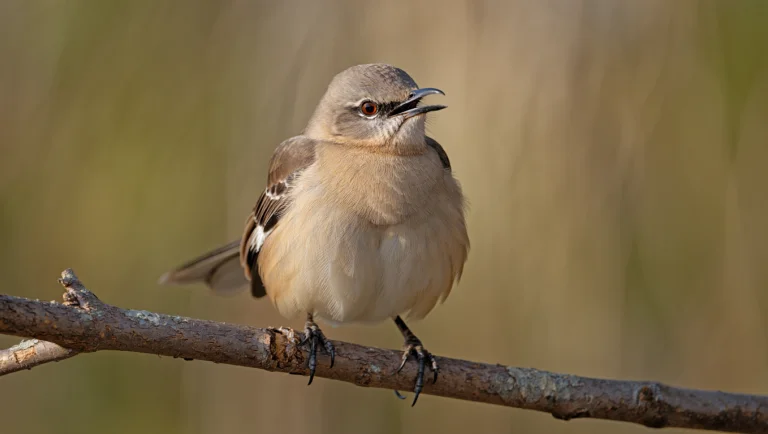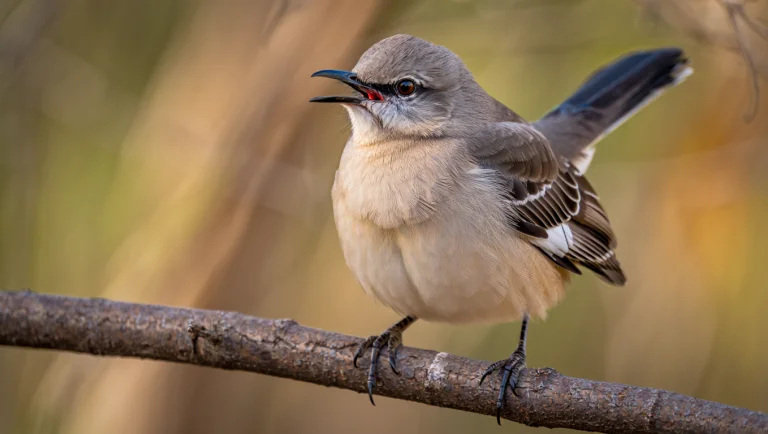Discover 5 fascinating facts about the Arkansas state bird, the Northern Mockingbird. Learn about its amazing vocal abilities, habitat, and how to attract this melodious mimic to your yard.

Table of Contents
Discover the fascinating world of the Northern Mockingbird, Arkansas’s beloved state bird, and learn why this melodious mimic captures the hearts of bird enthusiasts across the Natural State.

Introduction to Arkansas’s Feathered Ambassador
Arkansas, known for its natural beauty and diverse wildlife, proudly claims the Northern Mockingbird (Mimus polyglottos) as its state bird. This charismatic songbird was officially designated as the Arkansas state bird in 1929, joining several other southern states that also recognize this remarkable avian as their official representative.
The Northern Mockingbird has been capturing the hearts of Arkansans and bird enthusiasts alike with its extraordinary vocal abilities, distinctive behaviors, and adaptable nature. Whether you’re an avid birder, a casual wildlife observer, or simply curious about Arkansas’s natural heritage, exploring the world of the mockingbird reveals fascinating insights into the state’s ecological identity.
In this comprehensive guide, we’ll dive deep into five captivating aspects of the Arkansas state bird that make it truly special. From its incredible vocal repertoire to its bold personality, the mockingbird’s story intertwines with Arkansas’s cultural and natural landscape in remarkable ways. So, spread your wings and join us as we explore what makes the Northern Mockingbird a perfect emblem for the Natural State.

1. The Master Mimic: Extraordinary Vocal Abilities
The Voice of a Thousand Birds
The Northern Mockingbird earned its scientific name Mimus polyglottos for good reason – it translates to “many-tongued mimic,” perfectly describing this bird’s remarkable vocal abilities. As Arkansas’s state bird, the mockingbird showcases one of nature’s most impressive performances through its extensive repertoire of songs and calls.
Unlike many birds that have a single distinctive call, the Arkansas state bird can mimic up to 200 different sounds throughout its lifetime. These include songs from other bird species, animal sounds, mechanical noises, and even human-made sounds like car alarms or musical instruments. This vocal versatility makes the mockingbird a true avian virtuoso in Arkansas’s natural symphony.
Learning and Innovation
What makes the mockingbird’s vocal abilities even more impressive is how they learn and develop their songs. Male mockingbirds typically have a broader repertoire than females, using their varied songs to establish territory and attract mates. Research has shown that mockingbirds with more diverse song repertoires tend to be more successful in reproduction – a true testament to the evolutionary advantage of their musical talents.
Dr. Emily Richardson, an ornithologist from the University of Arkansas, explains: “Mockingbirds are continually adding new sounds to their repertoire. They listen to the soundscape around them and incorporate what they hear, making each mockingbird’s song unique to its environment and experiences.”
Night Serenades
One of the most distinctive habits of the Arkansas state bird is its tendency to sing at night, especially during breeding season and under moonlight. These midnight performances have inspired countless poems, stories, and songs throughout American culture. When you hear a complex medley of varied bird calls under the Arkansas moonlight, chances are you’re listening to a Northern Mockingbird’s nocturnal serenade.
2. Physical Characteristics and Identification
Appearance and Field Markers
While the Northern Mockingbird might not flaunt flashy colors like some of its avian counterparts, it possesses an elegant and distinctive appearance that makes it relatively easy to identify among Arkansas’s diverse bird population.
The Arkansas state bird typically measures between 8-11 inches in length with a wingspan of approximately 12-15 inches. Its plumage is predominantly gray-brown on the upper parts with a lighter gray to white underside. Two distinctive white wing bars become prominently visible during flight, along with large white patches on the wings and outer tail feathers – creating a striking pattern when the bird is in motion.

Distinctive Features and Behaviors
Beyond its coloration, the mockingbird can be identified by several characteristic behaviors:
- Wing Flashing: The Arkansas state bird has a peculiar habit of periodically spreading its wings to display the white patches, even when not in flight. This behavior, known as “wing flashing,” is thought to startle insects from ground cover, making them easier to catch.
- Active Foraging: Mockingbirds are often seen hopping energetically on lawns and open ground, running short distances and suddenly stopping to investigate potential food sources.
- Perching Prominence: These confident birds frequently perch in visible locations – on fenceposts, telephone wires, or atop shrubs – especially when singing.
- Distinctive Flight Pattern: The mockingbird’s flight pattern involves short, jerky wingbeats followed by brief periods of gliding, creating an undulating path through the air.
Arkansas bird-watching enthusiast James Wilson shares: “Once you’ve learned to spot the mockingbird’s white wing patches and observe its bold, animated behavior, you’ll find them all across the state. They’re not at all shy about making their presence known.”
3. Habitat and Distribution Across Arkansas
Where to Find the State Bird
The Northern Mockingbird has adapted remarkably well to human presence, making it one of the most commonly encountered birds across Arkansas. While many bird species have specific habitat requirements, the Arkansas state bird demonstrates impressive versatility in where it can thrive.
Mockingbirds can be found in virtually every county in Arkansas, from the highlands of the Ozarks and Ouachitas to the lowlands of the Mississippi Delta and Gulf Coastal Plain. Their adaptability makes them year-round residents throughout the state, providing bird enthusiasts with ample opportunity to observe them during any season.
Preferred Environments
Though adaptable, the Arkansas state bird does show preferences for certain habitat types:
- Urban and Suburban Areas: Mockingbirds readily inhabit residential neighborhoods, parks, school campuses, and business districts across Arkansas cities like Little Rock, Fayetteville, and Jonesboro.
- Agricultural Settings: Farm edges, orchards, and pastures provide ideal mockingbird habitat, offering both open foraging areas and scattered trees or shrubs for nesting and singing perches.
- Natural Areas: In less developed parts of Arkansas, mockingbirds favor open woodlands, forest edges, riparian corridors along the state’s numerous rivers, and brushy fields.
- State Parks: Visitors to Arkansas state parks like Petit Jean, Devil’s Den, or Village Creek can readily observe mockingbirds along trail edges and in open areas.
Population Trends in Arkansas
The Northern Mockingbird population has remained relatively stable across Arkansas in recent decades, according to data from the Arkansas Audubon Society’s annual bird counts. This stability speaks to the species’ adaptability and resilience in the face of habitat changes.
The Arkansas Game and Fish Commission reports that mockingbird populations tend to be densest in the central and southern portions of the state, with slightly lower numbers in the more heavily forested regions of the Ozark Highlands. However, ongoing urbanization and agricultural practices continue to reshape the distribution of these adaptable birds across the Natural State.
4. Diet and Feeding Habits
Omnivorous Opportunists
The Northern Mockingbird’s diet reflects its adaptable nature, shifting seasonally to take advantage of available food sources throughout Arkansas’s diverse ecosystems. As omnivores, these birds consume a varied diet that includes both animal and plant matter.
Insect Consumption
During spring and summer months, the Arkansas state bird primarily feeds on insects and other small invertebrates, making it a valuable ally for Arkansas gardeners and farmers. Some of their favorite insect foods include:
- Beetles
- Grasshoppers and crickets
- Ants
- Wasps
- Moths and caterpillars
- Spiders
The mockingbird’s hunting technique involves scanning the ground from a perch, then swooping down to capture prey. They also employ their characteristic “wing flashing” behavior to startle insects into movement, making them easier to spot and catch.
Fruit and Berry Feasting
As summer transitions to fall and winter, the Arkansas state bird shifts its diet to include more fruits and berries. Their fruit consumption includes:
- Native Arkansas berries like blackberries and elderberries
- Fruits from ornamental plants such as pyracantha and holly
- Wild grapes
- Persimmons
- Hackberries
- Dogwood fruits
This dietary flexibility allows mockingbirds to remain in Arkansas year-round rather than migrating south during winter months when insects become scarce.
Garden Visitors
For Arkansas homeowners looking to attract the state bird to their yards, planting native fruit-bearing shrubs and trees provides excellent mockingbird habitat. The University of Arkansas Cooperative Extension Service recommends:
“Including plants like American beautyberry, elderberry, and serviceberry in your landscape not only attracts mockingbirds but also provides habitat for other native wildlife. Supplementing with a bird bath or water feature makes your yard even more attractive to these charismatic birds.”
5. Breeding and Nesting Behaviors
Courtship Displays
The breeding season for Arkansas’s state bird typically begins in early March and can extend through August, with pairs often producing multiple broods during this period. Male mockingbirds initiate the breeding process with elaborate courtship displays that showcase their vocal prowess and territorial energy.
The courtship ritual of the Northern Mockingbird is a spectacular performance involving:
- Singing extensively from prominent perches, cycling through their entire repertoire
- Performing “flight displays” where males fly upward 25-50 feet before descending with slow, fluttering wingbeats
- Carrying nesting material or food items as demonstration of their provider capabilities
- Chasing potential mates in short, playful flights
Nest Construction
Once a pair bond forms, both male and female mockingbirds participate in nest construction, though females typically do most of the actual building. In Arkansas, mockingbird nests can be found in:
- Dense shrubs and small trees, particularly thorny species like hawthorn or honey locust
- Ornamental landscaping in suburban yards
- Small, dense evergreens
- Tangled vines and briars
The nest itself is a sturdy cup-shaped structure composed of twigs, grass, leaves, and other plant materials, with a soft inner lining of rootlets, moss, animal hair, or even synthetic materials like dryer lint or string. Construction typically takes 2-4 days to complete.
Parental Care
Female mockingbirds typically lay 3-5 blue-green eggs with brown speckles, incubating them for approximately 12-13 days. Both parents share responsibility for feeding the nestlings, which fledge about 12 days after hatching but continue to receive parental care for several weeks afterward.
Arkansas wildlife biologist Dr. Mark Thompson notes: “What’s particularly interesting about mockingbird parenting is how fiercely they defend their nests. They’ll dive-bomb potential predators many times their size, including hawks, cats, and even humans who venture too close to their nesting sites.”

Multiple Broods
In Arkansas’s lengthy warm season, mockingbird pairs often produce 2-3 broods per year. While the female begins incubating a new clutch of eggs, the male often continues caring for fledglings from the previous brood – demonstrating the species’ remarkable parental investment and reproductive strategy.
6. Cultural Significance in Arkansas
Literary and Musical Inspirations
The Northern Mockingbird has deeply influenced Arkansas’s cultural landscape, appearing in literature, music, and folklore throughout the state’s history. Perhaps most famously, the mockingbird inspired the title of Harper Lee’s classic novel “To Kill a Mockingbird,” which, while not set in Arkansas, resonates with many Arkansans for its portrayal of Southern society and the symbolic innocence of the mockingbird.
Arkansas’s rich musical tradition also references the state bird in numerous folk songs and ballads. The mockingbird’s ability to sing through the night has made it a powerful metaphor in spirituals and blues music that emerged from the Arkansas Delta region.
State Pride and Identity
Since its official designation in 1929, the mockingbird has become an important symbol of Arkansas identity. Its image appears on state literature, tourism brochures, and educational materials. Many Arkansas schools incorporate the state bird into their curriculum, teaching students about the mockingbird’s characteristics as part of their state heritage education.
The Arkansas Game and Fish Commission features the mockingbird prominently in its wildlife education programs, using the state bird to introduce children to concepts of adaptability, habitat, and conservation.
Mockingbird in Local Art
Arkansas artists frequently feature the state bird in their work, from wildlife paintings to crafts and sculptures. The annual Arkansas Mockingbird Festival in Little Rock celebrates the state bird through art exhibitions, bird-watching tours, and educational workshops about avian conservation.
Local artisan Sarah Jenkins, who creates mockingbird-themed pottery, explains: “There’s something about the mockingbird that really captures the Arkansas spirit – adaptable, musical, and with more depth and complexity than you might initially expect. That’s why it resonates with so many of us who call this state home.”
7. Conservation Status and Challenges
Current Population Status
The Northern Mockingbird enjoys a relatively secure conservation status in Arkansas and throughout most of its range. The International Union for Conservation of Nature (IUCN) classifies the species as “Least Concern,” and breeding bird surveys indicate stable populations across most of Arkansas.
According to data from the Arkansas Audubon Society, mockingbird populations have remained consistent over the past several decades, with some fluctuations in density between urban and rural areas. The Arkansas state bird’s adaptability to human-modified landscapes has contributed significantly to its success in maintaining healthy population numbers.
Threats and Challenges
Despite their overall stable status, mockingbirds in Arkansas face several challenges:
- Habitat Fragmentation: While adaptable to human presence, mockingbirds still require suitable nesting sites and food sources. Intensive urban development that removes shrubs and small trees can reduce available habitat.
- Predation: Domestic and feral cats pose a significant threat to mockingbirds, particularly during the nesting season when birds are focused on protecting their young.
- Pesticide Use: As insectivores, mockingbirds can be affected by pesticides both directly through exposure and indirectly through reduction in their food supply.
- Climate Change: Shifting weather patterns and seasonal timing may affect food availability and breeding success for Arkansas’s state bird over time.
Conservation Efforts
Several initiatives support mockingbird conservation in Arkansas:
- The Arkansas Game and Fish Commission’s Watchable Wildlife program promotes awareness and appreciation of native birds, including the state bird.
- Audubon Arkansas works to protect bird habitat throughout the state, benefiting mockingbirds and other native species.
- The University of Arkansas Cooperative Extension Service provides guidance to homeowners on creating bird-friendly landscapes that support mockingbirds and other wildlife.
“While mockingbirds aren’t currently threatened, their continued success depends on maintaining diverse habitats across Arkansas,” explains Dr. Emily Richardson. “Preserving patches of native vegetation in both urban and rural settings ensures these iconic birds will continue to thrive.”
How to Attract Mockingbirds to Your Arkansas Home
Many Arkansas residents enjoy attracting the state bird to their yards and gardens. Creating a mockingbird-friendly landscape not only provides opportunities to observe these fascinating birds up close but also contributes to local conservation efforts.
Landscape Elements
To attract mockingbirds to your Arkansas property, consider including these landscape features:
- Dense Shrubs: Plant native shrubs like American beautyberry, elderberry, or viburnum to provide nesting sites and shelter.
- Fruit-Bearing Plants: Include native fruits and berries that mockingbirds enjoy, such as dogwood, holly, wild grape, and blackberry.
- Open Areas: Maintain some open lawn or ground cover where mockingbirds can hunt for insects.
- Perching Sites: Provide elevated perches like fence posts, trellises, or small trees where mockingbirds can sing and survey their territory.
- Water Features: Install a birdbath or small pond to offer drinking and bathing opportunities.
Feeding Considerations
While mockingbirds don’t typically visit seed feeders, you can attract them with:
- Fruit Feeders: Platform feeders with fresh or dried fruits like apples, grapes, or raisins
- Mealworms: Offering mealworms in a dish or tray feeder, especially during breeding season when protein needs are high
- Suet Mixtures: Suet cakes containing fruit pieces or insects
Creating a Safe Environment
To ensure the safety of mockingbirds visiting your property:
- Limit or eliminate pesticide use in your yard
- Keep cats indoors or supervised outdoors
- Provide sufficient distance between feeding areas and potential hiding places for predators
- Respect nesting areas during breeding season, giving mockingbirds space if they establish a nest on your property
Arkansas native plant specialist Robert Johnson advises: “The most successful mockingbird habitats integrate seamlessly with the local ecosystem. Using plants native to Arkansas not only attracts our state bird but supports the entire food web they depend upon.”
Fascinating Mockingbird Behaviors to Watch For
For bird enthusiasts in Arkansas, observing the state bird’s unique behaviors adds another dimension to the enjoyment of these charismatic creatures. Here are some distinctive mockingbird behaviors to watch for:
Territorial Displays
Northern Mockingbirds are famously territorial, particularly during breeding season. Males defend territories that can span up to 2 acres in size, vigorously chasing away intruders – including much larger birds, mammals, and even humans who venture too close to their nests.
Their territorial displays often include:
- Raising and fanning their wings to display the white patches
- Performing direct flight toward the intruder
- Vocalizing loudly with alarm calls
- In extreme cases, actually striking the perceived threat
Mirror Aggression
One of the most unusual behaviors of the Arkansas state bird is its tendency to attack its own reflection. Mockingbirds may spend hours fighting with their mirror images in windows, car mirrors, or other reflective surfaces, perceiving the reflection as a territorial rival.
This behavior is most common during spring breeding season when territorial instincts are heightened. Arkansas homeowners sometimes report mockingbirds repeatedly striking windows or car mirrors, occasionally to the point of exhaustion.
Cooperative Defense
While mockingbirds are territorial toward their own kind, they sometimes engage in cooperative defense against predators. Research has documented cases where multiple mockingbirds from neighboring territories will join forces to mob potential threats like hawks, owls, or snakes.
This cooperative behavior benefits all nearby nesting birds and demonstrates the mockingbird’s intelligence and social complexity.
FAQ About the Arkansas State Bird
When was the Northern Mockingbird designated as Arkansas’s state bird?
The Northern Mockingbird was officially designated as the Arkansas state bird in 1929. This selection followed a campaign led by the Arkansas Federation of Women’s Clubs, who advocated for the mockingbird due to its presence throughout the state and its melodious songs.
Does the Northern Mockingbird migrate from Arkansas during winter?
No, the Northern Mockingbird is a year-round resident throughout Arkansas. Unlike many other songbirds that migrate south for winter, mockingbirds have adapted to find sufficient food sources during Arkansas winters, primarily by shifting their diet to include more fruits and berries when insects become scarce.
How can I tell the difference between a Northern Mockingbird and similar gray birds?
The Arkansas state bird can be distinguished from similar gray birds by several key features: prominent white wing patches visible during flight, white outer tail feathers, relatively long legs, and a slightly curved bill. Compared to catbirds or thrashers, mockingbirds have a more slender appearance and lack the rusty undertail of catbirds or the streaked breast of thrashers. Their behavior—including wing flashing and bold, conspicuous perching—also helps with identification.
Do Northern Mockingbirds reuse their nests?
Typically, Northern Mockingbirds build new nests for each brood rather than reusing old ones. In Arkansas, where mockingbirds often raise 2-3 broods per breeding season, a pair might construct multiple nests within their territory over the course of spring and summer. Occasionally, they may reuse the foundation of an old nest, building a new cup atop the previous structure.
Is it legal to keep a Northern Mockingbird as a pet in Arkansas?
No, it is illegal to keep a Northern Mockingbird as a pet in Arkansas or anywhere in the United States. As native migratory birds, mockingbirds are protected under the federal Migratory Bird Treaty Act of 1918, which prohibits the capture, possession, or harassment of these birds without proper permits. Violations can result in significant fines and penalties.
What’s the lifespan of the Arkansas state bird?
In the wild, Northern Mockingbirds typically live 8-10 years, though some individuals have been documented to reach 20 years of age. Survival rates are highest for established adult birds that have secured territories with abundant food sources and suitable nesting sites.
Conclusion
The Northern Mockingbird truly embodies the spirit of Arkansas—adaptable, resourceful, and full of surprising complexity. As the state’s avian ambassador since 1929, this remarkable songbird continues to captivate residents and visitors alike with its extraordinary vocal abilities, distinctive behaviors, and charismatic presence across Arkansas’s diverse landscapes.
From the urban parks of Little Rock to the rural farmlands of the Arkansas Delta, the mockingbird’s melody provides a consistent soundtrack to life in the Natural State. Its ability to thrive alongside human development while maintaining its wild character makes it an appropriate symbol for a state balancing natural heritage with progress.
Whether you’re an experienced birder or simply an appreciative observer of nature, taking time to notice and understand the Arkansas state bird enriches your connection to the local environment. The next time you hear a complex, multi-part song coming from a prominent perch, pause to appreciate the Northern Mockingbird—nature’s own virtuoso and Arkansas’s feathered pride.
Have a similar experience with your pet or wild birds around your home? Share it in the comments below!







